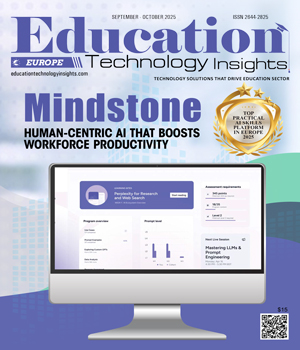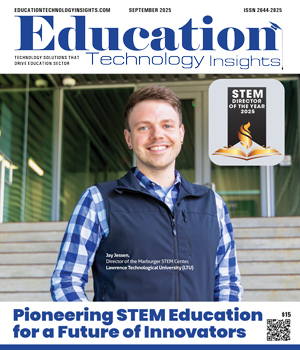THANK YOU FOR SUBSCRIBING
Be first to read the latest tech news, Industry Leader's Insights, and CIO interviews of medium and large enterprises exclusively from Education Technology Insights
Will ChatGPT end Higher Ed? Not So Fast
Dr. Mira Lalovic-Hand, Senior Vice Chancellor and CIO, Rowan University
 Dr. Mira Lalovic-Hand, Senior Vice Chancellor and CIO, Rowan University
Dr. Mira Lalovic-Hand, Senior Vice Chancellor and CIO, Rowan UniversityMira Lalovic-Hand, Senior Vice Chancellor and CIO at Rowan University, is a transformative technology leader who was honored with PhillyCIO’s ORBIE award in 2024. Passionate about innovation and process improvement, she helped Rowan University reinvent itself from a regionally ranked state institution to a top 100 public research university in less than a decade. She is also a committed educator and mentor, particularly for underrepresented populations in technology.
Higher education has weathered crises for nearly a millennium, despite repeated predictions of its collapse.
In just the last decade, headlines have declared that the pandemic, the looming enrollment cliff, rising tuition costs, and federal cuts to research funding pose existential threats to the industry. For some institutions, those predictions came true. Colleges closed or merged under the weight of poor business decisions or late pivots. But the industry has endured, and it will continue to do so in the face of the latest challenge: generative artificial intelligence (gen AI).
GenAI has made it radically easier to gather, analyze and create content. With a simple prompt, tools like ChatGPT, Gemini, Copilot and others can develop personalized lesson plans, write essays, generate data visualizations and summarize research findings. With capabilities like these, critics question whether higher education can compete. If you can learn at your own pace with a tool tailored to your needs, why would students continue to pay for a college degree?
The answer is clear: higher education does not simply transfer information. It provides the framework to transform that information into knowledge, the benchmarks employers rely on to judge whether graduates can apply that knowledge in the workplace and the space for discovery that fuels both individual growth and societal progress.
Why Higher Ed Endures
The university model of higher education dates back nearly 1,000 years. The University of Bologna — the oldest university in the Western world — first opened its doors around 1088, with Oxford University following about a decade later. Since then, higher education has navigated political and technological revolutions, societal and cultural upheavals and major demographic shifts. While some colleges and universities have faltered under the weight of that change, higher education as an industry has survived.
That’s because higher education delivers a product society values. Colleges and universities are places of structured learning, where students are guided through a deliberate sequence of experiences that teach them not just what to think, but how to think. They are also places of discovery and innovation, where students are encouraged to explore new ways of thinking, challenge preconceptions and make new connections.
“The real question is not whether higher education will survive GenAI. The question is how boldly we will embrace it”
At the end of their experience, students receive a degree that certifies their competence in a specific domain. Employers use those credentials to validate whether job candidates have the professional skills they need, and studies show those credentials increase income mobility, drive civic engagement and even improve personal health.
These functions are not easily replaceable or replicable. That is why higher education has endured for a millennium, and why it will continue to endure even in the face of technology that can produce and analyze content on demand. That’s not to say higher education won’t look different in the future. It will, and it must.
How GenAI Will Shape Higher Ed — and Vice Versa
ChatGPT and tools like it have put a personal tutor in the hands of every student; a teaching and research assistant in the hands of every faculty member; and an administrative assistant in the hands of staff and managers. The temptation to cede core knowledge work, or to simply cut corners, while using these tools is strong. Higher education must adapt to this new reality, just as it has adapted to past technological revolutions.
The difference at this moment in time is the unprecedented pace and scale of genAI adoption, and the risks are broader than those posed by the printing press, modern computing or the internet. They include:
• Cheating and plagiarism
• Misinformation and bias
• Data privacy and security
Higher education must not only adapt, but lead, on these issues to shape how genAI tools are used in the classroom and throughout society. Many colleges and universities have already started.
• Arizona State University and other institutions have developed training modules, role-specific resources and guidelines on using genAI, as well as developed communities of practice that are exploring how these tools may improve teaching and learning and drive innovation.
• The University of Michigan was the first to provide a custom suite of generative AI tools to its campus community, providing a private, digital environment for experimentation and innovation, and Harvard University, Vanderbilt University and others have also created internal genAI platforms for exploratory use.
• All Day TA, an AI-powered teaching assistant developed by professors at the University of Toronto, provides students with 24/7 support tailored for their course and has been adopted by around 100 universities and business schools.
These are just a few examples of how higher education is not just reacting to genAI but taking proactive steps to experiment, adapt and set standards for how these tools will be used.
Universities have long been incubators for new ideas and technologies; GenAI is no exception.
New Tech Brings New Cyber Threats
As with any new technology, information technology professionals must set guardrails to ensure that technology is not exploited or misused.
One recent study found education faced an average of more than 4,000 attacks per week per institution in the first quarter of 2025, more than any other industry. Now, the unique nature of genAI has created fresh pipelines for sensitive data to leak, a new attack surface for hackers and a new tool for hackers to make their attacks more believable.
To protect data and enable secure innovation, universities must embed cybersecurity into their genAI adoption strategies, with clear policies for responsible use, strong governance and continuous training for students, faculty and staff.
Done right, these safeguards won’t stifle exploration; they will enable it.
The Larger Risk
Strong cybersecurity is only one piece of the puzzle. The larger challenge is how higher education adapts to generative AI overall. Like the technologies that have preceded it, genAI will transform how we teach, learn and research.
Institutions that resist change, or that invest too late in the wrong areas, may disappear. But those that embrace innovation while preserving the enduring values of higher education will thrive.
GenAI marks the beginning of a new era, one in which colleges and universities have the opportunity to reinvent themselves once again. So, the real question is not whether higher education will survive GenAI. The question is how boldly we will embrace it.
Read Also
From At-Risk to At-Promise: The Language Revolution Higher Education Needs
Teaching Tomorrow: How Western Governors University Is Redefining Teacher Preparation
Shaping Future Engineers Through Innovation and Hands-On Learning
From Isolation to Interaction: Reimagining Technology for Human Connection
Building an Understanding of AI in Learning Environments
Integrating SEL, Digital Citizenship, and AI Literacy in K–8 Schools

I agree We use cookies on this website to enhance your user experience. By clicking any link on this page you are giving your consent for us to set cookies. More info

However, if you would like to share the information in this article, you may use the link below:
www.educationtechnologyinsightseurope.com/cxoinsights/dr-mira-lalovic-hand-nid-3452.html





















